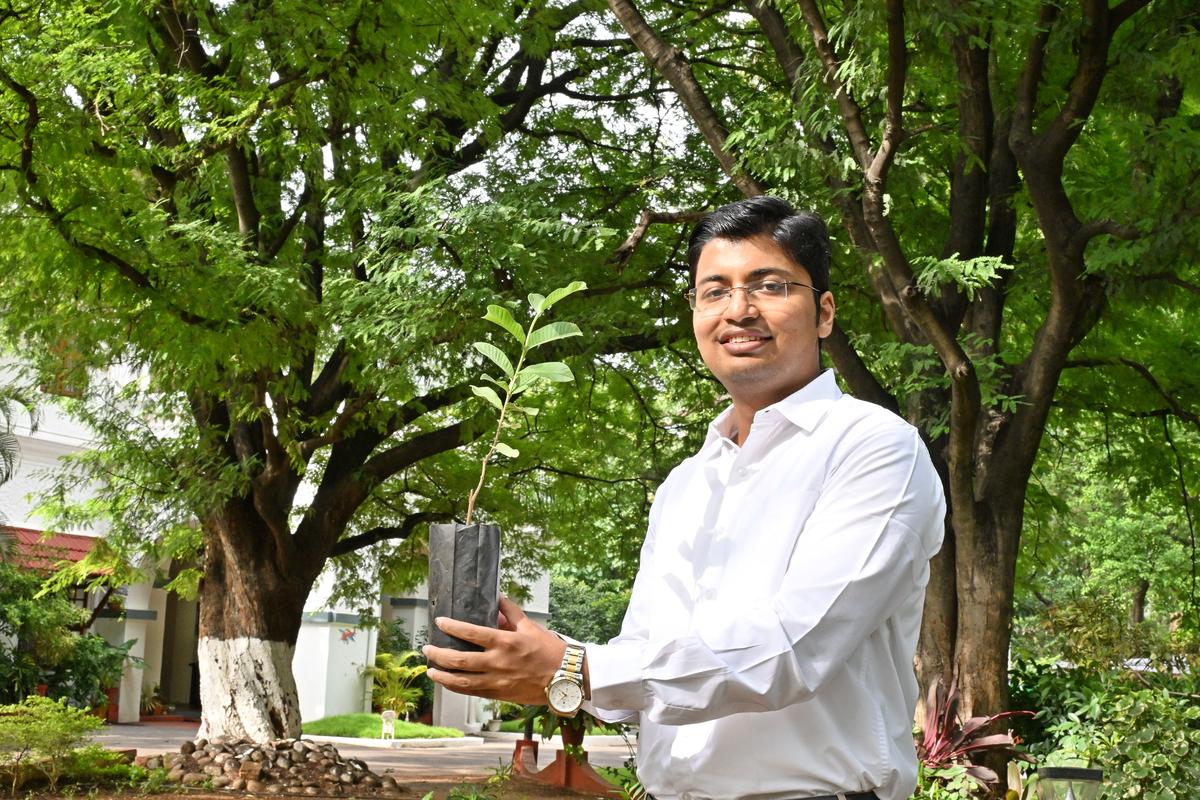[ad_1]

Coimbatore District Collector Kranthi Kumar Pati IAS during an interaction on green drives initiated in the city
| Photo Credit: Siva Saravanan S
A welcoming cool breeze and the intoxicating fragrance of brown vaagai flowers can uplift one’s spirits instantly. The vaagai tree (Indian siris) thrived from the Sangam era when kings wore garlands made of its flowers after their battlefield victories. While Sorga maram (paradise tree) helps cut down radiations of mobile phone towers, iluppai (mahua) trees bring rains, and the naatuvangam (false Ashoka) filters dust and controls pollution. Environmentalists believe that native trees purify the air and are beneficial to both people and the environment. In Tamil Nadu, some villages such as Velampalayam, Puliampatti, Ichipatti, and Arasmapalyam are named after native trees that have flourished there for ages. Many insects, birds, and animals depend on these trees for food and shelter.
Soon, Coimbatore’s cityscape will be dotted with such mindful green spaces of huge-canopied vengai(Malabar kino), marudhu (Arjun tree), banyan, peepal, and fig. Over 12 lakh native trees will be added as part of the Green Tamil Nadu Mission (GTM), a flagship programme of the state government.
Here is how the mission works. The Forest Department is entrusted with growing saplings later distributed to other government departments and the public. The planted seedlings are georeferenced for effective tracking and monitoring.

Coimbatore District Collector Kranthi Kumar Pati IAS
| Photo Credit:
Siva Saravanan S
“The aim is to improve the green cover,” says district collector Kranthi Kumar Pati IAS adding that they set an annual plan involving various government departments to achieve the yearly target. “We also bring the work done by private institutions under this umbrella. Under the agroforestry initiative, the agriculture department encourages farmers to plant saplings. It adds two lakh trees. The rural development department, through their MGNRGEA scheme, cover another two lakh trees,” he explains.
Local bodies use their Open Site Reservation lands for tree plantation. Additionally, NGOs also nurture green spaces on suitable lands with CSR contributions. “Everyone contributes to the tree plantation drives in a major way,” he says, adding that native tree species are encouraged as it is well suited for the ecology and will survive better in adverse weather conditions. “During natural calamities like cyclones, most foreign trees like the mayflower are uprooted while native trees stand the test of time,” says eco-warrior M Yoganathan, who has planted over four lakh saplings across the districts of Tamil Nadu in the last 30 years.
Saplings at the DFO compound in Coimbatore
| Photo Credit:
PERIASAMY M
The saplings, Kranti Kumar says, are nurtured at the nurseries of the Forest Department, horticulture, and the District Rural Development Agency. “The highways department is expected to plant ten trees for every tree that is cut. So they also raise saplings to meet this demand. The consensus is that the saplings should be raised till they are five to six feet in length to ensure better survival,” says Kranthi Kumar, who set the precedent by refusing permission to cut 27 trees along the 16-kilometre stretch from Ambarampalayam to Sethumadai.
“Coimbatore is a city with a tiger reserve, a reserve forest and at the same time a thriving industrial, education, and healthcare hub. We have to balance the need for infrastructure while protecting our environment. When the request came up from the highway department to cut tamarind trees, most of them over 50 years old, along the Anamalai Road leading to Top Slip, we evaluated and then explored alternative options. So, we have added speed breakers and roadside mirrors at the junction to improve visibility. The green committee at the district level, including NGOs like Siruthuli, Kaushika Neer Karengal, which are active in the space of greenery entry plantations review such requests. ‘Is it necessary to cut trees?’ ‘Can we transplant and save some trees?’ are some of the questions we ask,” he says.

Most green drives kick-start during the monsoons and continue till January of the following year. “The city gets copious water during the Southwest and the Northeast monsoon. We plan to improve the green cover across the lakes fed by the Noyyal. The interconnected tanks act as a buffer zone during intense rain spells. As a reservoir, it prevents flooding and recharges the groundwater table, allowing farming to flourish. It supports life forms, a good ecosystem of birds and fishes. Once the Under Ground Sewage System coverage is 100 per cent and there are more Sewage Treatment Plants, the quality of water will improve greatly,” he says, adding that the Semmoli Poonga coming up in a 140-acre area will cover 45 acres in the first phase and will include ample greenery.

“Additionally, private organisations with CSR contributions are developing a park for the differently abled in Kalapatti. In Ukkadam township area that also has an art street, a small park is being developed with greenery.” School children are roped in regularly to drive home the message on green drives. Kranthi Kumar adds, “At schools, in addition to sessions on solid waste management, traffic rules, they also learn about caring for Nature. While caring for trees, they develop empathy, and eventually turn conservationists.”
Published – October 10, 2024 07:34 pm IST
[ad_2]
Source link





